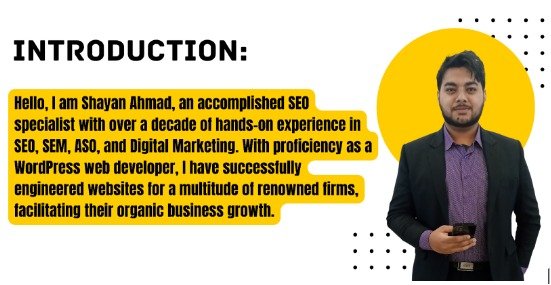Shayan Ahmad’s SEO Mastery: Maximizing Online Visibility
Hello, I am Shayan Ahmad, an accomplished SEO specialist with over a decade of hands-on experience in SEO, SEM, ASO, and Digital Marketing. With proficiency as a WordPress web developer, I have successfully engineered websites for a multitude of renowned firms, facilitating their organic business growth. For inquiries or collaborations, feel free to reach out to me at linktoshayan@gmail.com. You can also explore my Upwork profile here to discover more about my expertise and past projects.
1. Introduction to SEO Mastery
Search Engine Optimization (SEO) has become one of the most essential elements of a successful digital strategy. Whether you’re an entrepreneur, a small business owner, or part of a large corporation, mastering SEO is key to staying visible in the crowded online marketplace. With search engines serving as the gateway to the internet for most users, ensuring that your website appears at the top of search results can significantly impact your business. In this article, we’ll dive deep into the SEO strategies that I’ve employed over the years, helping countless businesses grow their online presence organically.
2. Core Principles of SEO
SEO is a broad field encompassing various strategies and practices, but it all boils down to two core aspects: on-page SEO and off-page SEO. On-page SEO includes optimizing elements on your website like title tags, meta descriptions, and content to align with relevant search queries. Off-page SEO, on the other hand, involves building a site’s authority through external backlinks and brand mentions across the web. Both strategies are necessary to achieve long-term success in SEO.
3. Keyword Research Techniques
Effective SEO begins with thorough keyword research. By identifying the terms your target audience is searching for, you can tailor your content to meet their needs. Tools like Google Keyword Planner, SEMrush, and Ahrefs are invaluable for finding high-volume, low-competition keywords that will drive traffic to your site. However, it’s important to go beyond the basics and consider long-tail keywords, LSI keywords, and user intent to truly optimize your strategy.
4. Optimizing Content for SEO
Once you’ve identified the right keywords, integrating them into your content in a natural and meaningful way is crucial. Overstuffing keywords can lead to penalties, while underusing them might result in missed opportunities. Balancing keyword density, creating engaging headlines, and structuring content with headings and subheadings are all part of a well-rounded approach to SEO content creation.
5. Technical SEO Essentials
Technical SEO refers to the behind-the-scenes elements of your site that affect its performance in search engines. This includes optimizing your site’s speed, making it mobile-friendly, ensuring it is secure (HTTPS), and making it easily crawlable for search engine bots. Tools like Google Search Console can help identify any technical issues that might be holding back your SEO performance.
6. Local SEO Strategies
For businesses targeting a local audience, optimizing for local SEO is vital. This includes setting up and optimizing your Google My Business profile, building local citations, and ensuring your business information is consistent across the web. By doing so, you can increase your chances of appearing in local search results and the coveted Google Maps pack.
7. Link Building Strategies
Building quality backlinks from reputable websites is one of the most important factors in improving your domain authority. But not all links are created equal—focus on acquiring backlinks from high-authority websites relevant to your industry. Strategies like guest blogging, broken link building, and creating shareable content can help attract these valuable links.
8. SEO Tools and Analytics
SEO is a data-driven field, and leveraging the right tools can make a world of difference in your success. Google Analytics and Google Search Console are must-haves for tracking performance and identifying areas for improvement. Additionally, third-party tools like SEMrush, Moz, and Ahrefs can provide deeper insights into your SEO efforts, competitor analysis, and keyword tracking.
9. Mobile SEO Optimization
With more users accessing the web via mobile devices, mobile SEO is no longer optional. A mobile-first approach ensures that your site is responsive, loads quickly, and provides a seamless experience on all devices. Google’s mobile-friendly test and PageSpeed Insights can help identify areas for improvement.
10. The Role of User Experience
User experience (UX) plays a significant role in SEO. A well-designed site that’s easy to navigate will keep visitors engaged longer, reducing bounce rates and increasing the likelihood of conversions. Search engines take these engagement metrics into account when determining rankings.
11. SEO in E-Commerce
E-commerce websites face unique SEO challenges, from managing product pages to handling duplicate content. Optimizing product descriptions, utilizing structured data for rich snippets, and ensuring fast load times are just a few of the strategies that can help e-commerce sites thrive in organic search results.
12. SEO for Voice Search
As voice search continues to grow, it’s important to optimize your content to cater to this trend. Voice search queries tend to be longer and more conversational, so targeting long-tail keywords and optimizing for question-based searches can help capture this audience.
13. Future Trends in SEO
The world of SEO is constantly evolving, with search engine algorithms becoming more sophisticated and user behavior changing over time. Staying on top of trends like AI-driven SEO, the rise of video content, and the growing importance of Core Web Vitals will help ensure long-term success.
14. Measuring SEO Success
To truly master SEO, it’s essential to track and measure your efforts. Key metrics to monitor include organic traffic, keyword rankings, bounce rates, and conversion rates. By analyzing these metrics, you can adjust your strategy to continually improve your results.
15. Conclusion
Mastering SEO is a continuous process that requires dedication, knowledge, and adaptability. By understanding the core principles and staying up-to-date with the latest trends, you can significantly improve your online visibility and drive sustainable business growth.
FAQs
- What is SEO and why is it important?
SEO stands for Search Engine Optimization. It helps businesses increase their visibility on search engines like Google, leading to more traffic and potential customers.
- How long does it take to see SEO results?
SEO is a long-term strategy, and results can take anywhere from a few months to a year, depending on your industry and competition.
- What are the most important factors in SEO?
The most important factors include keyword research, quality content, technical SEO, and backlinks.
- How often should I update my SEO strategy?
SEO strategies should be reviewed and updated regularly, especially after major algorithm changes or shifts in user behavior. https://softnewsdaily.com/
- What tools are essential for SEO?
Google Analytics, Google Search Console, SEMrush, and Ahrefs are some of the most important tools for any SEO strategy.
- Can I do SEO on my own, or should I hire a professional?
While anyone can learn the basics of SEO, hiring a professional can help you achieve better results more efficiently.






